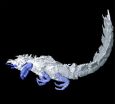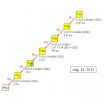(Press-News.org) Writing in the journal PLoS One, the scientists have used a high resolution form of CT scanning to reconstruct two 305-million year old juvenile insects. Without the pioneering approach to imaging, these tiny insects – which are three-dimensional holes in a rock – would have been impossible to study.
By placing the fossils in a CT scanner, and taking over 3,000 X-rays from different angles, the scientists were able to create 2,000 slices showing the fossil in cross section.
From these slices the researchers created 3D digital reconstructions of the fossils. This process allows them to learn more about the lifestyle, biology and diet of the insects, one of which is similar to a modern day cockroach, and glimpse fascinating insights about how both were adapted for survival.
One of the insects reconstructed by the scientists is characterised by a large number of sharp spines. It is a new species and genus which does not exist today.
The other is an early predecessor of one of the great survivors of the insect world, the cockroach, and is one of the best preserved examples of this age ever seen by insect palaeontologists. Researchers suspect from its well preserved mouthparts that it survived by eating rotting litter from the forest floor.
Both are members of a group called the Polyneoptera – which includes roaches, mantises, crickets, grasshoppers and earwigs. But analysing the exact relationships of the insects will be difficult for the researchers, led by Dr Russell Garwood of the University of Manchester's School of Materials, as insects have a habit of dramatically changing appearance as they develop.
Dr Garwood said: "The most dramatic change is seen in insects like butterflies, which change from a larva, to chrysalis, to adult. But relatively few people look to the fossils try and work out how such a life cycle may have evolved.
"We are hoping that work like this will allow us to better understand the biology and development of these early insects, and how major innovations may have come about.
"Around this time a number of early 'amphibians' were insectivores – they lived by eating a lot of insects. The spiney creature was a sitting duck, as it couldn't fly, so the spines probably made it less palatable. It is bizarre – as far as we're aware, quite unlike any members of the Polyneoptera alive today."
"The roach nymph is much like modern day cockroaches – although it isn't a 'true' cockroach, as it may well predate the split between true cockroaches and their sister group, the mantises."
"This is very much a first step, and I'll be spending the next few years looking at other fossil insects to build on this work.
Professor Philip Withers, co-author on the paper, added: "I am very excited by our fossil work which is providing unique information in 3D."
INFORMATION:
Images of 300 million old insects revealed
2012-09-26
ELSE PRESS RELEASES FROM THIS DATE:
Robotic surgery through the mouth safe for removing tumors of the voice box, study shows
2012-09-26
COLUMBUS, Ohio – Robotic surgery though the mouth is a safe and effective way to remove tumors of the throat and voice box, according to a study by head and neck cancer surgeons at the Ohio State University Comprehensive Cancer Center – Arthur G. James Cancer Hospital and Richard J. Solove Research Institute (OSUCCC – James).
This is the first report in the world literature illustrating the safety and efficacy of transoral robotic surgery for supraglottic laryngectomy, the researchers say.
The preliminary study examined the outcomes of 13 of head and neck cancer patients ...
Computers match humans in understanding art
2012-09-26
Southfield, MI - - Understanding and evaluating art has widely been considered as a task meant for humans, until now. Computer scientists Lior Shamir and Jane Tarakhovsky of Lawrence Technological University in Michigan tackled the question "can machines understand art?" The results were very surprising. In fact, an algorithm has been developed that demonstrates computers are able to "understand" art in a fashion very similar to how art historians perform their analysis, mimicking the perception of expert art critiques.
In the experiment, published in the recent issue ...
Coral hotspots found in deepwater canyons off northeast US coast
2012-09-26
For the first time in decades, researchers have conducted an extensive exploration for deep-sea corals and sponges in submarine canyons off the northeastern coast of the US. The survey revealed coral "hotspots," and found that a new coral habitat suitability model could help predict where corals are likely to occur. The model is being developed by the Northeast Fisheries Science Center (NEFSC) and the National Ocean Service's Biogeography Branch.
Among the canyons surveyed during the July 6-18 cruise aboard the NOAA Ship Henry B. Bigelow were Toms, Middle Toms, and Hendrickson ...
Study pinpoints epigenetic function of common cancer-causing protein – it's not what science thought
2012-09-26
Squamous cell carcinoma (SCC) is diagnosed in about 700,000 people in the United States every year. Commonly contributing to SCC is a protein called DNp63a – it goes abnormally high and the ability of a patient's body to kill cancer cells goes abnormally low. In many cases of SCC, it's just that simple. And science thought the function of DNp63a was simple, as well: the tumor suppressor gene p53 is responsible for recognizing and killing cancer cells, and in SCC, it's usually inactivated. It looked like high DNp63a repressed p53, made SCC.
A University of Colorado Cancer ...
The rich colors of a cosmic seagull
2012-09-26
Nebulae are among the most visually impressive objects in the night sky. They are interstellar clouds of dust, molecules, hydrogen, helium and other ionised gases where new stars are being born. Although they come in different shapes and colours many share a common characteristic: when observed for the first time, their odd and evocative shapes trigger astronomers' imaginations and lead to curious names. This dramatic region of star formation, which has acquired the nickname of the Seagull Nebula, is no exception.
This new image from the Wide Field Imager on the MPG/ESO ...
Search for element 113 concluded at last
2012-09-26
The most unambiguous data to date on the elusive 113th atomic element has been obtained by researchers at the RIKEN Nishina Center for Accelerator-based Science (RNC). A chain of six consecutive alpha decays, produced in experiments at the RIKEN Radioisotope Beam Factory (RIBF), conclusively identifies the element through connections to well-known daughter nuclides. The groundbreaking result, reported in the Journal of Physical Society of Japan, sets the stage for Japan to claim naming rights for the element.
The search for superheavy elements is a difficult and painstaking ...
Researchers uncover biochemical events needed to maintain erection
2012-09-26
For two decades, scientists have known the biochemical factors that trigger penile erection, but not what's needed to maintain one. Now an article by Johns Hopkins researchers, scheduled to be published this week by the Proceedings of the National Academy of Sciences (PNAS), uncovers the biochemical chain of events involved in that process. The information, they say, may lead to new therapies to help men who have erectile dysfunction.
"We've closed a gap in our knowledge," says Arthur Burnett, M.D., professor of urology at Johns Hopkins Medicine and the senior author ...
Moffitt Cancer Center researchers say smoking relapse prevention a healthy step for mothers, babies
2012-09-26
Researchers at Moffitt Cancer Center, concerned that women who quit smoking during their pregnancies often resume smoking after they deliver their baby, tested self-help interventions designed to prevent postpartum smoking relapse.
"We'd first like to see more women quit smoking when they become pregnant," said Thomas H. Brandon, Ph.D., senior member at Moffitt and chair of the Department of Health Outcomes and Behavior. "However, even among those who do quit, the majority return to smoking shortly after they give birth."
According to the researchers, nearly 50 percent ...
Severe hunger increases breast cancer risk in war survivors
2012-09-26
Jewish women who were severely exposed to hunger during World War Two were five times more likely to develop breast cancer than women who were mildly exposed, according to research in the October issue of IJCP, the International Journal of Clinical Practice.
The study also found that women who were up to seven-years-old during that period had a three times higher risk of developing breast cancer than women who were aged 14 years or over.
Sixty-five women diagnosed with breast cancer between 2005 and 2010 were compared with 200 controls without breast cancer. All ...
Slave rebellion is widespread in ants
2012-09-26
Ants that are held as slaves in nests of other ant species damage their oppressors through acts of sabotage. Ant researcher Professor Dr. Susanne Foitzik of Johannes Gutenberg University Mainz (JGU) in Germany first observed this "slave rebellion" phenomenon in 2009. According to the latest findings, however, this behavior now appears to be a widespread characteristic that is not limited to isolated occurrences. In fact, in three different populations in the U.S. states of West Virginia, New York, and Ohio, enslaved Temnothorax longispinosus workers have been observed to ...



